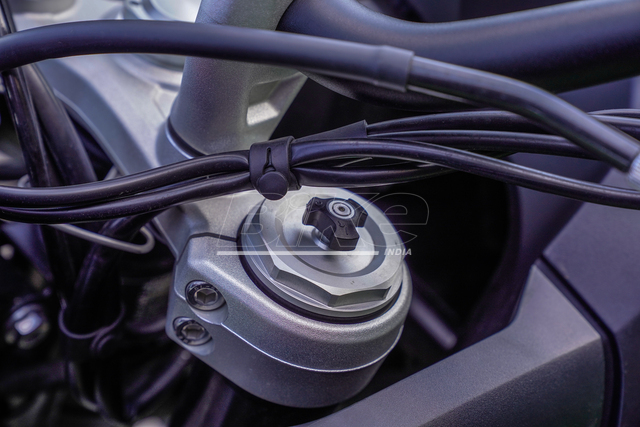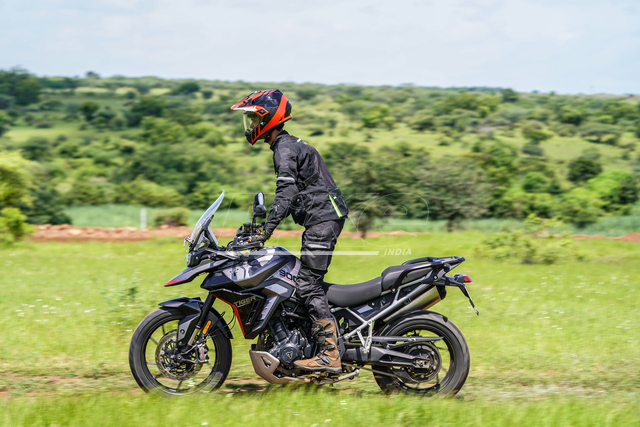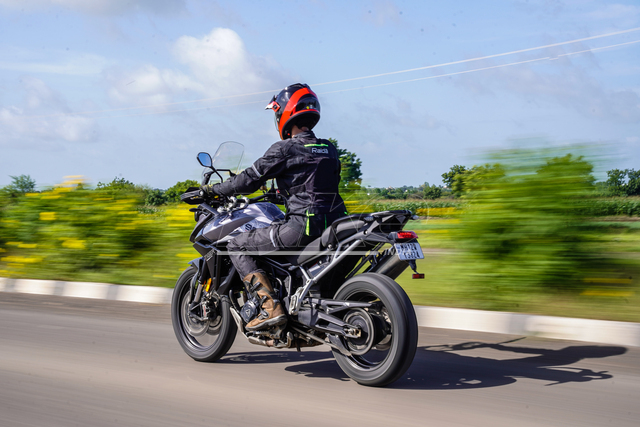The engine of this motorcycle has been updated and here is why the GT makes a compelling argument as a tourer.

Story: Joshua Varghese
Photography: Sanjay Raikar
For most motorcycles, updates are usually limited to aesthetics or, in some cases, ergonomics and electronics. Triumph have gone one step further by actually extracting more power from an engine we have appreciated since its launch in 2020. Here is what stood out for us after riding the latest Triumph Tiger 900 GT.
In some markets, those who want a Tiger for the road can choose between the GT and the GT Pro but in India, we get only the GT. What are we missing out on? Not much because most of the kit that is offered as standard in the Pro is available as an option in the GT. Electronic adjustability for preload at the rear and the customizable Rider mode are possibly the only things one may miss. This particular motorcycle we tested had some optional kit, including a quick-shifter and sump-guard. Some may opt for the centre-stand, too, for ease of maintenance.
Design seems to have been of least priority in this update because, save for a slight tweak to the panels surrounding the fuel-tank, the Tiger looks largely the same. The console has received a significant upgrade because they have borrowed the seven-inch screen from the Tiger 1200. In my opinion, it has a better layout overall. However, it takes an incredibly long time to come to life and the animation while navigating through the menus looks unbecoming of a motorcycle that costs this much.

Comfort over long distances is key to being a GT and Triumph have improved the rider seat significantly. The plush seat complements the overall riding position well and it put me in a place to manoeuvre the motorcycle without any discomfort even after a few hours in the saddle. The windscreen is manually adjustable but even at its highest setting, I found myself wishing for better wind protection. However, that could be a problem faced only by riders over six feet tall. With the new padding, seat height has increased by 10 millimetres but one can adjust it to either 820 or 840 mm. At 820 mm, it is reasonably accessible for most people because of the way it tapers towards the fuel-tank.

The liquid-cooled, in-line, triple-cylinder engine displaces the same 888 cc as before but the compression ratio has been increased to 13.0:1. Consequently, there is more power and torque; 108 hp at 9,500 rpm (almost eight hp more) and 90 Nm at 6,850 rpm (an increase of three Nm). While there is no noticeable change in the engine’s character, it feels slightly more potent than it used to. ‘More fun’ covers it adequately. In Road mode, the throttle response is smooth and linear while Sport’s urgent response is best suited to a rapid run along some twisties.
With a strong bottom end and an explosive mid-range, the Tiger feels right at home when the tachometer says 5,000 rpm. For reference, in sixth gear at 5,000 rpm the motorcycle was clocking about 130 km/h (indicated). There is enough torque available early in each gear to execute quick overtakes but once past 5,000-6,000 rpm, vibrations creep in at the handlebar despite it being rubber damped. To be fair, it is only a concern if one intends to ride at speeds in excess of 130 km/h for long durations. Its six-speed transmission shifts smoothly and the need for a quick-shifter was not evident; however, it does make life a little easier.

No changes in the suspension this time. Marzocchi units handle things at either end. The USD fork is adjustable for compression and rebound while the monoshock offers adjustability for preload and rebound. It is tough to find fault with the Tiger’s handling because it responds to steering input admirably for a motorcycle that weighs 219 kilograms. While one needs a screwdriver to adjust the rebound at the rear, all other adjustments can be made by hand. It took some experimenting but we were able to find a set-up that worked best for us. Once the settings for performance and comfort have been identified, it becomes a motorcycle that has the potential to behave exactly how the rider wants it to. It could be fast and sporty along some switchbacks or calm and relaxed on the highway. Having remote adjustability for preload makes it easier to make the most of the motorcycle with or without pillion/luggage. No changes in the brakes either; they continue to be just as capable as they always were. Triumph claim the brakes have been linked but its effect was hardly noticeable.
With 180 mm travel at the front and 170 mm at the rear, the GT has some off-road potential but with the Metzeler Tourance Next tyres, it is best not to go looking for the trails. That said, we did not have any problems with mild off-roading.
The Triumph Tiger 900 GT costs Rs 13.95 lakh (ex-showroom), which is Rs 25,000 more than its predecessor. With this significant update, it now commands attention in a space that it has defined for itself because it does not have any direct rivals. All things considered, it may just be all the motorcycle one needs to explore roads that lead across the country.
Also Read: Triumph Speed T4 Tested Review








Leave a Reply